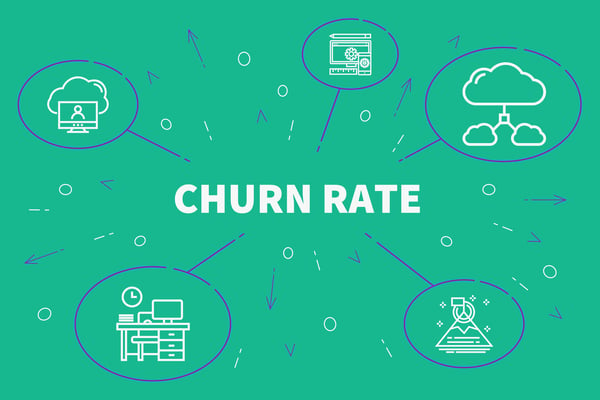6 SaaS Sales Metrics And What They Mean
6 SaaS Sales Metrics And What They Mean
Get weekly
HubSpot Updates
Everyone talks about metrics in digital marketing, but few actually get under the hood of what they mean and how they apply to your business.
When it comes to selling software as a service (SaaS), knowing how to interpret your numbers can make a huge difference in how you generate leads, manage existing customers and combat churn.
So, without further ado, let's take a look at the seven essential SaaS sales metrics you need to understand.
1. Conversion rate
There's a bit of confusion around this term. Conversion doesn't only refer to how many leads you've turned into paying customers. It can also be used to indicate how many visitors took a desired action on your website. Your calls-to-action (CTAs) should be pushing prospects to sign up for emails, download content offers, and take part in surveys.
The formula for working out your conversion rate is :
[Total Number of Sales] / [ Number of Leads ] x 100 = ?%
A high conversion percentage shows that your site is well designed and offers a good user experience (UX). So if you're not getting the numbers you expect, perhaps it's time to review the layout and design of your website, as well as the quality of your content and the effectiveness of your CTAs.

2. Customer lifetime value (LTV)
This is a particularly important metric for subscription-based SaaS businesses. Churn is a common problem for this industry, and the cost of acquisition can be high. Understanding the total value that a customer will bring to your business throughout your relationship with them helps to create better marketing strategies that focus on the sustainable growth of your profits.
This calculation will help you to understand how much money your customers are likely to spend with you over a period of time, and how you can tailor your offers to ensure their continued support.
To work out LTV, use this formula:
[ Average Order Cost] x [ Number of Purchases] x [Loyalty Period]

3. Customer churn rate
Churn—an unpleasant sounding word with unpleasant consequences. This metric refers to the number of clients who bounced out of your buyer's journey. Perhaps they were only free trialers, or they had committed to a purchase and then cancelled as soon as the terms and conditions allowed them to do so.
Churn is the result of poor engagement and, possibly, a weak customer retention strategy. In SaaS, this is the number you want to keep a close eye on because without regular, returning customers, your profits are going to sink like the Titanic.
The formula to work out your churn rate percentage:
[Number of Clients that Left by the End of the Month] / [ Total Number of Clients that paid for the Next Month] x 100.
Understanding this figure will help you to segment your customers better and identify any issues in your onboarding process.

4. Visitor-to-lead conversion rate
Knock-knock. Who's there?
Not your lead!
Do you see traffic on your website, but none of it is turning into a paying customer or taking any desired actions? A possible cause could be heavy top-of-the-funnel (TOFU) effort from your sales and marketing teams, but not a lot of evaluation and decision stage content to capture leads. Or, you're just not attracting your ideal buyer personas.
The formula for visitor-to-lead conversion rate:
[Number of Visitors Who Became Leads] % [Total Number of Visitors] x 100%
When you know your visitor to lead conversion rate, you can see what opportunities you may be missing and figure out why you may be drawing in low-value traffic.

5. Lead-to-customer conversion rate
So, you've started optimising your content and improving your UX. Now your visitors are finally starting to become leads. But how do you get them to pay for a subscription?
Knowing your lead-to-customer rate will help you to get those sales-ready leads over the last hurdle and into your loyal subscriber group.
Calculate your lead-to-customer conversion rate like this:
[Total number of monthly customers] / [ Total number of monthly leads] x 100%
When you analyse this metric monthly, you will be able to gain insight into how specific marketing campaigns are performing and tweak them accordingly. You can also use this information to improve your conversion stage content or up the frequency of your time-sensitive offer emails.

6. Win rate
This is the number of trophies your SaaS business collects at industry awards. Okay, that's not true. But secretly, you know you'd like a few of those "Innovator of the Year" awards.
Your win rate is more about your sales reps and their ability to (in the immortal words of Alec Baldwin as the salesman in Glengarry Glen Ross) Always Be Closing.
To work out how your sales reps are performing, you can use this formula:
[Number of Opportunities] / [Total Opportunities] x100
While a positive number from this metric may be encouraging, you should always question whether a spike in sales is simply a reflection of your sales team taking advantage of an easy-access market segment. If that's the case, those leads will soon dry up, and you'll know that a more long term strategy, and more in-depth segmentation is necessary.
In this article, we've covered the basics as far as metrics for SaaS sales are concerned. If your team is new to the game, it's worth sharing this content so that everyone can get up to speed with the terminology and learn more about the numbers that matter when planning your sales growth strategy.
It's essential to report on these metrics monthly so that you can set goals and key performance indicators (KPIs) that help to coordinate everyone's efforts.
If you'd like to learn more about this topic or speak to an expert about any underperforming metrics that you're noticing on your reports, get in touch with us today.
Our content includes affiliate links. This means that we may receive a commission if you make a purchase through one of the links on our website. This will be at no cost to you and helps to fund the content creation work on our website.